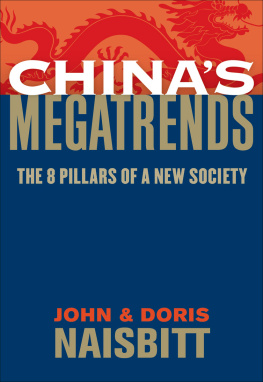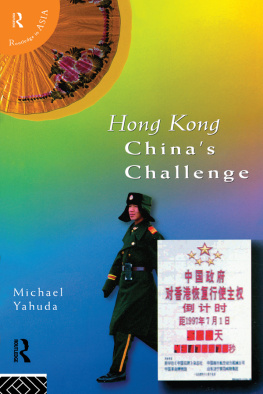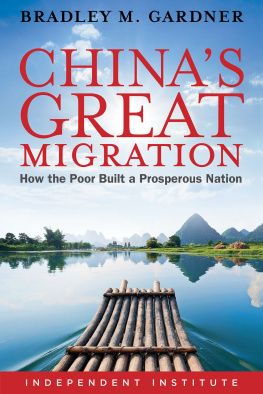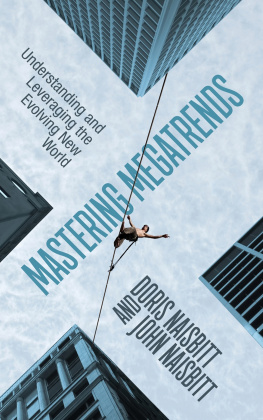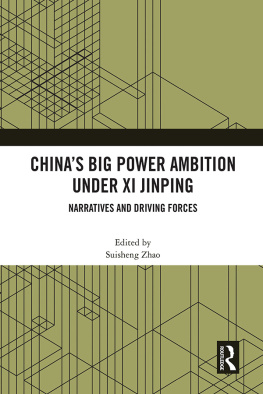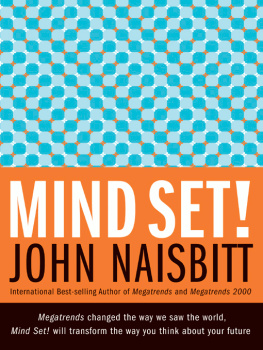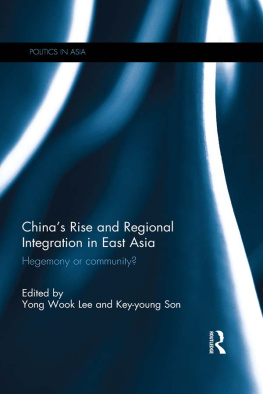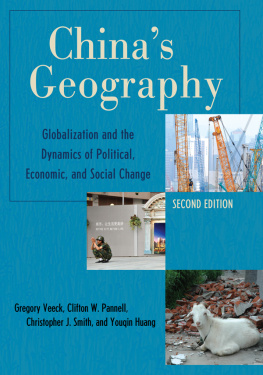A New System on the Rise
For many years I carried a regret, the feeling I had missed one of the great opportunities in life. It was back in 1996 and the offer I received was made by one of the most powerful men of the time: Jiang Zemin, the president of China.
It was at a private meeting at the leadership compound in Beijing, in the same room where Mao had received his guests. The reason for Jiang Zemins invitation was Megatrends , a book I had written in 1982 analyzing the economic, political, social, and cultural transition taking place in the United States. It was on the best-seller list of the New York Times for more than two years, mostly as number one, and became a huge global success. Megatrends also made its way to China, and to my surprise I was told that it must have sold at least 20 million copies in China alonepirated copies, a common distribution system at the time. The members of the first generation after the Cultural Revolution had just graduated from colleges and universities and were hungry and eager to learn from the West. You dont know how famous you are in China, were the very first words President Jiang said to me.
Before my visit to Beijing I had spent a few days in Taipei. This was a critical period in relations between the United States and China. President Clinton had deployed aircraft carriers in response to Chinas sending missiles into waters close to Taiwan. The two countries were teetering at the brink of a clash over Taiwan, and so it was not surprising that Taiwan was the elephant in the room during our two-hour conversation. Before very long, Taiwan became a subject of discussion. I had visited both China and Taiwan many times since 1967, and I had witnessed the huge changes that had taken place. I noticed the unspoken discomfort with how well Taiwan presented itself to the world and how modest Chinas presentation was in comparison. So I said, President Jiang, Taiwan has a small story to tell, and tells it very well. China has a big story to tell, and does a terrible job in telling it.
Silence.
And then: Why dont you tell it? We will give you all the support you need.
As tempting as that offer was, I could not accept it. I was too much engaged in other things. Andfor whatever reasonI was not ready.
Ten years later, the offer came back, this time from Chinas new corporate world. It happened during the taping of a television program. I was having a dialogue with a Chinese businessman, Wang Wei, who had founded one of Chinas first mergers and acquisitions firms and was also head of the China Mergers & Acquisitions Association. He had studied and worked in New York and returned to China in 1992. As the dialogue was recorded, we had time between takes and soon became engaged in a lively conversation about China and its future. Wang Wei told me that he had read Megatrends in 1982 and that it had been a great influence on him.
A few days later I received an e-mail from him: There are many books about Chinas past and Chinas rise and about Chinas political, economic, and cultural future. But what we need is an analysis as you did in Megatrends . Not even the Chinese know what is really going on in China and where it is headed. Why dont you find out and write about what Chinas megatrends are?
This time I was ready, not only because ten more years of traveling China extensively had increased my visits to China to a total of more than one hundred, and deepened my understanding of the country and its people, but also because this time I would not do it alone. Over the last decade I have been traveling in China with my wife, Doris. She was my German-language publisher before she became my wife in 2000. As it turned out, she was a perfect match in more ways than one. We travel the world together, do our research together, and share the excitement about what is happening in China. She was with me when we got to know Wang Wei, who has become a very good friend, a most reliable partner, a great supporter, and the initiator of this book.
Only a few months after our first conversations and his e-mail to me, together with another Chinese partner we founded the Naisbitt China Institute as an independent, stand-alone institute, strongly supported by Nankai University and Tianjin University of Finance and Economics (I am a professor at both universities). Our commitment was to step back from the western view and assumptions, and look at China as the Chinese look at their country; we would be open to its shortcomings, but would not judge China by our own values and standards.
At first we needed to collect as much information as possible about what was happening on the ground. We started intense meetings with our staff, as many as twenty-eight students and graduate students from two universities in Tianjin, led by Chinese entrepreneurs and academics. We briefed them about what we were looking for. First, and most important, they should collect only facts, things that have indeed been doneno plans, no declarations. Second, they had to get used to the principle that we did not frame the subjects; any frame would have given the research a certain direction, and thus we would have missed what we were hoping to findthings we did not know, things that would surprise us. This process was unusual compared with the Chinese way of thinking. A third challenge was to shorten and translate the media articles that were selected and make them into the database.
It was truly a pleasure to work with our team, and also to have met with students in other parts of China.
In parallel with this monitoring of local Chinese media, Doris and I traveled around China, interviewing entrepreneurs, academics, politicians, artists, dissidents, and expatriates, always keeping our goal in mind: to tell the Chinas story from the inside out, not from the outside in as most recent books on China have done.
We were in search of Chinas megatrends. We were aware that we were looking at a country undergoing great and very complex change, with each region and each city moving at its own level and its own speed. We were looking for patterns, in which a series of single events would begin to make sense and form a picture of the new China, just as such events did in the United States in 1982, when I wrote Megatrends .
What we found was of much greater dimensions and importance than we had anticipated. We concentrated on the obvious shifts in the social, political, cultural, and economic life of the country, but it seemed that those shifts were only the result of something elsesomething overarching, which we could not define. Then, one afternoon in Beijing, it became clear to us, and we wondered why we had not seen it before. Whereas America in 1982 had been transforming within a system that was already well in place, China in 2009 is creating an entirely new social and economic systemand a political model, which may well prove that the end of history was just another pause along historys path.
John Naisbitt, May 2009
CHINAS 8 PILLARS OF A NEW SOCIETY
- Emancipation of the Mind
- Balancing Top-Down and Bottom-Up
- Framing the Forest and Letting the Trees Grow
- Crossing the River by Feeling the Stones
- Artistic and Intellectual Ferment
- Joining the World
- Freedom and Fairness
- From Olympic Medals to Nobel Prizes
The concept of the 8 pillars and their selection and description are entirely the work and responsibility of the authors.

